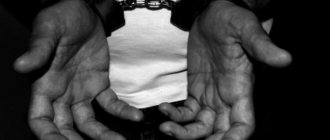According to the norms of Russian legislation, any unfinished criminal act constitutes an attempt. For example, if a person tried to steal someone else's property and was detained, he was attempted theft, and if there was an attempt to kill, he was attempted murder.
Despite the apparent simplicity of the definition of a crime, in practice quite often problems arise with the qualification of such an act. For example, it may be difficult for authorized persons and the victim to determine what exactly the criminal wanted: to simply make a threat and back it up with actions, or to actually kill a person.
The article under the Criminal Code of the Russian Federation for attempted murder provides for many signs that make it possible to accurately determine the intentions that guided the criminal when committing an unlawful act.
Download for viewing and printing:
Criminal Code of the Russian Federation of June 13, 1996 N 63-FZ
What does attempted murder mean?
Committing such an illegal act is possible only with direct intent.
Consequently, when committing such actions, the guilty person wished the death of the victim and tried to achieve a lethal outcome to the crime. Such actions can be qualified as this illegal act only if the actions of the criminal were stopped or suppressed (he failed to fulfill his intentions). That is, for objective reasons, the person’s death never occurred.
Attempted murder of a person can be classified under the following articles:
- Part 3 of Article 30 of the Criminal Code of the Russian Federation.
- Article 105 of the Criminal Code of the Russian Federation.
Download for viewing and printing:
Article 30. Preparation for a crime and attempted crime of the Criminal Code of the Russian Federation
Article 105. Murder of the Criminal Code of the Russian Federation
If during the trial the guilt of the accused is proven, he cannot be subject to punishment exceeding ¾ of the maximum amount of liability provided for in the articles.
Important: Based on the norms of the Criminal Code, attempted murder means the impossibility of the criminal, for objective reasons, to complete his intent.
Arbitrage practice
If we talk about judicial practice in cases of murder under Article 105 of the Criminal Code of the Russian Federation, it is worth noting that before establishing responsibility for a crime, the court takes into account many factors:
- qualifications (qualified murder or unqualified misdemeanor);
- lawyer's speech;
- connections with criminal groups;
- video evidence;
- mock crime.
The court considers the case for at least a month (this time is necessary to familiarize yourself with the case materials, determine the punishment, and consider the problem individually). The legislation (its norm) does not limit the period of consideration (there may be several appeals, rescheduling of hearings, etc.) - this can last a year or more.
The lawyer representing the interests must have an appropriate diploma. Court decisions are often made in favor of the victim - the perpetrator then ends up in punishment. There he may be subject to an amnesty after some time. He can also ask for parole. The basis for this will be a positive characteristic from the colony.
The jurisdiction of such cases most often is at the place of residence of one of the subjects or the place where the crime was committed. For example, a crime against citizen Lebedev was committed in Zelenograd by a group of people from Lipetsk. The case may be considered at the place where it was committed.
Types of unfinished murder
Responsibility applies not only in “ordinary” attempts to lead to death, but also in a number of exceptional cases:
- If it was planned to carry out qualified murder with aggravating circumstances.
- If a mother tries to take the life of her newborn child, but for some reason she fails to complete her plan.
- If the death was caused in a state of passion (strong emotional disturbance of a person, which arose suddenly due to the commission of illegal actions by the victim).
You are viewing the Murder section
- Immediately or shortly after birth, the mother kills her newborn child. It is believed that in this case the woman is in a state of extreme stress and often loses the ability to fully understand and control her actions. Article 106 is considered very ambiguous by practicing criminologists and ordinary people. The need to tighten punishment for mothers in such cases has been discussed for a long time.
- Murderers often appeal to Article 107, which talks about the state of passion. If a person has become a victim of bullying or torture, he can often turn into a punisher. In such cases, one of the key factors in proving/refusing affect is the conclusion of a psychological and psychiatric examination.
- One of the less recognized articles by the courts is the excess of defensive measures. Judicial practice knows a huge number of cases when crimes are reclassified from Art. 108 at station 105. Murders specifically under Article 108 are considered one of the most difficult to prove.
When an assassination attempt is impossible
In relation to some illegal acts, there cannot be an attempt. Despite the fact that the death was prevented, the provisions of Article 30 of the Criminal Code do not apply to such crimes.
When self-defense limits are exceeded
Article 108 of the Criminal Code of the Russian Federation provides for holding the guilty person accountable for committing two types of illegal acts that were directed against human life:
- A murder committed by a person exceeding the permissible limits for self-defense.
- A murder that was the result of exceeding the measures the use of which was necessary to apprehend the criminal.
Article 108. Murder committed when exceeding the limits of necessary defense of the Criminal Code of the Russian Federation
The right to defense is a natural right of any person, enshrined at the legislative level. However, if such limits are exceeded, the actions of a citizen countering crime can also be considered an illegal act.
At the level of Russian legislation, a separate norm considers the commission of a murder that occurred when the culprit repelled an attack of a socially dangerous nature.
Such actions will not be considered as exceeding the limits of self-defense, and therefore cannot entail criminal prosecution of the person who committed such actions.
When causing death by negligence
The object of such an illegal act is also human life, however, according to the norms of criminal law, such actions cannot be classified as murder.
Such a death can occur due to the frivolity of the accused, due to his negligence. Such a crime should be distinguished from innocent causing of death, which occurs when the following conditions are met:
- The person did not have the opportunity to foresee the death of the victim, and should have done this according to the circumstances of the case.
- If a person had the opportunity to foresee a likely fatal outcome, but there was no way to prevent it due to the inconsistency of psychophysical qualities with extreme conditions and overloads.
Attention: The conclusion about a person’s guilt in committing such an unlawful act must be based on a thorough analysis of all actions committed by the accused and an objective assessment of the entire situation as a whole.
Problems of distinguishing crimes from other offenses
When studying the Criminal Code of the Russian Federation, it is possible to identify several crimes with a similar composition, which explains the difficulty of qualifying such illegal acts.
- Threat to commit murder. In practice, quite often there are situations when a person, shouting “I’ll kill,” points a knife at another citizen. Such actions are most often committed in the heat of a quarrel, but this does not prevent the problems of distinguishing such a crime from attempted murder. The qualification of the committed criminal act is determined by carefully studying all the circumstances of the case, the details of the incident and reliable information about the direction of the actions committed and the presence of intent. Since there is a huge difference between the penalties for such illegal actions, it is important to qualify them correctly.
- Serious bodily harm. As practice shows, crimes in which grievous bodily harm was caused to the victim are considered the most difficult when assessing the circumstances of the incident. When qualifying an unlawful act, it is necessary to take into account the fact whether the criminal had the intent to kill a person or whether there was a desire only to inflict serious injuries on him so that he would have to restore his health for a long time.
- The ability to complete actions. When delimiting crimes, the ability of the guilty person to complete his actions is also taken into account. For example, if a person strangled another citizen and was stopped by a third person, such actions may be regarded as an attempt. And if no one prevented the criminal from bringing the matter to death, but he stopped on his own, he will be held liable for causing grievous bodily harm.
How is the sentence term calculated?
The procedure for bringing a person to justice for committing actions characterized as attempted murder is clearly regulated by the relevant Resolution of the Armed Forces of the Russian Federation.
This regulatory act determines that the punishment for the perpetrator is applied in accordance with the standards established by Article 105 of the Criminal Code of the Russian Federation, but the chosen measure must be no more than ¾ of the maximum punishment established in the article. For example, for committing an attempt to kill a person that does not fall within the qualifications (without aggravating circumstances), Article 105 establishes a maximum term of imprisonment of up to 15 years. Accordingly, in the case of attempted murder, a person can be sentenced to a term of just over 11 years.
In what cases are more severe penalties provided?
More severe penalties are established for so-called qualified crimes, that is, murders that were committed with aggravating circumstances. In particular, such murders include:
- Murder of two or more people.
- The murder of a person carrying out official activities, or members of his family, because of his activities, fulfilling his duty to the public.
- The death of a young child or other person who, known to the guilty person, was in a helpless state at the time of the commission of the act.
- The murder of a pregnant woman, which the perpetrator knew about.
- The murder of a person committed with extreme cruelty.
- Death committed in a manner that poses a public danger.
- Actions and murders committed based on blood feud.
- A crime that was committed by a group of persons, including those situations where such citizens acted by prior conspiracy.
- Actions committed for hire or for selfish purposes.
- Acts committed to conceal other crimes or facilitate their commission.
- Murder motivated by racial, political or national hatred.
- Crimes committed for the purpose of further use of the victim’s organs or tissues.
Article 105 of the Criminal Code of the Russian Federation provides for liability for such illegal acts in the form of imprisonment for up to 20 years or life imprisonment. However, since a person cannot be sentenced for life for attempted murder, when calculating the sentence, the judge takes into account exactly the 20-year time period. Therefore, the maximum sentence for qualified attempt is 15 years.
You are viewing the Murder section
- At least two people (or more) become victims of murder.
- Criminals kill a person who fulfills his official duties and observes his public duty. Relatives of such a person can become victims.
- Murder + kidnapping. Here - causing the death of a young child or simply a clearly helpless person (disabled, elderly, sick).
- The victim is a pregnant woman, and the criminals know this.
- Particular cruelty of the crime (burning alive, slow drowning, with torture).
- The chosen method of murder is generally dangerous. It’s one thing to shoot a person in a dark alley, another thing to start a shootout in a shopping center, where there are many possible random victims.
- The motive is blood feud. The qualification of such cases involves a lot of nuances. For example, the killer must be related to a nation that practices such revenge.
- Murder is committed by a group of any degree of organization.
- The victim dies as a result of robbery, robbery, or bandit attack. As an option - hired murder, as well as obvious self-interest.
- Criminals are driven by hooligan motives. This may include the desire to distinguish oneself, to oppose oneself to the victim and the law.
- Rape + murder. The desire to hide some crime.
- There is a hostile attitude towards a person of a certain nationality, political beliefs, belonging to a hated religious denomination.
- Murder + use of internal organs/tissues.
Selected legal aspects of the crime
Jurisdiction, characteristics of the crime, arguments
Cases of attempted murder are heard by city or district courts.
Bringing the guilty person to justice occurs in accordance with the standards established in Article 105 of the Criminal Code of the Russian Federation. At the same time, the application of liability measures within the framework of Part 3 of Article 30 of this normative act is possible only in cases where, as a result of the commission of criminal actions, death did not occur.
The amount of punishment applied directly depends on the qualifications of the unlawful act.
Statute of limitations for bringing the perpetrator to criminal liability
The statute of limitations under which a guilty person can be held accountable for committing an unlawful act directly depends on the nature of the crime: the general statute of limitations is 15 years.
High-profile cases
High-profile attempted murder cases include:
- On heads of state, which is tantamount to an attack on the state itself and its structure.
- Religious leaders of states.
- Presidential candidates.
Here are just a few examples.
Assassination attempt on Joseph Stalin. On November 6, 1942, S. Dmitriev, who hid on the Execution Ground of Red Square and left his military unit without permission, fired shots at Stalin’s car, which was driving from the Spassky Gate. The criminal was disarmed by the guards, there were no casualties. Historians believe that the criminal confused Stalin's car with Mikoyan's car.
Attack on Vladimir Lenin. The most famous attack occurred on August 30, 1918 in Moscow. On this day, Lenin spoke at the plant named after. Mikhelson in Moscow. At the end, he was supposed to get into the car, but at that moment 3 shots were fired. Lenin was seriously wounded. The police immediately detained Socialist-Revolutionary Fani Kaplan, who admitted her guilt.
Attack on Adolf Hitler. On July 20, 1944, perhaps the most daring attempt to assassinate the Fuhrer was carried out. On that day, the future of war was influenced by an ordinary cabinet.
By the summer of 1944, Germany began to lose. But as long as the Fuhrer was in power, capitulation was impossible. These circumstances led some military personnel to the idea of overthrowing the Nazi regime. The first attempt was made on July 11 at a conference in Berchtesgaden. But the Fuhrer did not show up, which is why the mission was postponed. And already on July 20, Stauffenberg headed to the Fuhrer’s headquarters “Wolf’s Lair”. The colonel had 2 suitcases: with papers and with an explosive mechanism. At the meeting, the colonel asked to be seated next to Hitler, explaining that he had poor hearing, and placed explosives a few meters from Hitler. Under the pretext of talking on the phone, the colonel left the premises and activated the bomb. But the Valkyrie mission, which had the goal of seizing power and forming a provisional government, did not come true. After Stauffenberg left, Colonel Franz Brandt sat closer to the Fuhrer and moved the briefcase to another place on the cabinet. The explosion killed four people. However, Hitler was not injured. On the same day, Olbricht and Stauffenberg were shot.
Encroachment on Alexander II. In the fall of 1879, members of Narodnaya Volya planned to blow up the train on which Alexander II arrived from Crimea. But at the last minute the train changed its route. On November 18, when the train approached the terrorist, a Narodnaya Volya member tried to activate the bomb, but the explosion did not occur because the electrical circuit was faulty. Soon, Narodnaya Volya formed a third group to plant a bomb on a railroad track near Moscow. The plan failed due to unforeseen factors. In Kharkov, due to a breakdown of the baggage train, the Tsar's train was dispatched first. As a result, the criminals were only able to blow up a freight train.
Attack on Reagan. The assassination attempt took place on March 30, 1981. The President and three people from his escort group were wounded while leaving the Hilton Hotel, where Reagan was making a speech to trade unionists. The assassin was John Hinckley. At about 2:27 p.m., when Reagan left the hotel and headed to the car, Hinckley emerged from the crowd and fired 6 shots from a pistol in 3 seconds. The last bullet bounced off the body of the car, hit the president's chest, touched a rib and penetrated the lung. Hinckley was not convicted because of his insanity, but was committed to St. Helena Mental Hospital in Washington. On September 10, 2021, he was released from the medical facility and went to his mother’s house. His release is subject to certain conditions.
An attack on Putin. On March 2, 2008, a point was set up in a room on Sadovnicheskaya Street from where the shooter was supposed to fire a shot. The plan was to kill Putin and Medvedev as they moved along Vasilyevsky Spusk. A couple of hours before the opening of the official event, FSB officers entered the premises where the shooter Shakhvelad Osmanov was detained. The shooter was only charged with unlawful possession of a firearm.
The reasons and factors due to which a criminal act is not carried out to completion can be very different. But they always do not depend on the subject carrying out the attack and have no connection with the will and desire of the criminal. These may be unsuitable means of carrying out the criminal plan, impassable obstacles, unwanted witnesses, strong resistance of the victim of the attack, or the absence of the target of the attack.





